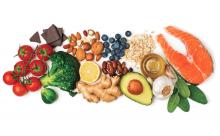Nutritious eating need not involve counting calories, carbohydrates, or points, according to food and nutrition editor Paul Kita.
After talking with experts and studying various diets, Mr. Kita said he found an approach that works for him.
The key is eating “real food,” such as chicken, tomatoes, eggs, and avocados; avoiding processed foods; and not demonizing anything. Approaching food this way for 10 years has allowed Mr. Kita to keep his weight at 155 pounds – give or take 5, – he wrote in Men’s Health.
“I eat cookies. I eat carbs. I even drink coffee supposedly loaded with mycotoxins,” Mr. Kita wrote. “I [eat] fruits and vegetables with every meal and cut back on booze and desserts. I have two clementines or a banana or a split broiled tomato for breakfast. I eat a big salad of mixed greens or a side of coleslaw or a ripe, juicy pear for lunch.”
He said dinner might include sautéed spinach or a carrot salad and roasted sweet potatoes. “And then I either choose to have a beer with or after dinner or a simple dessert. If I’m not craving something sweet, I’ll have a cup of tea.”
He said he tries for about 30 grams of protein at each meal.
“Here’s my main takeaway ... if the plan you have for what you feed yourself causes you more stress and adds more work to your already-busy life, you’re not eating well. The best diet ... doesn’t have celebrity endorsements. The best diet is one that is based on the inclusion of healthful foods – not the exclusion of food groups.”
Students seek to prevent suicides
The beauty of mountains can be breathtaking for someone passing through. For residents, living in the shadow of the giants, however, can be isolating, especially for small mountain communities. Grand Junction, Colo., is located in a valley ringed by tall mountains, desert mesas, and red-rock cliffs. For local residents, and especially teenagers, it can feel like the end of the world.
“I know we can’t really fix this because it’s nature,” 17-year-old Victoria Mendoza said in an NPR interview. “I feel like the people in our valley feel like there’s only life inside of Grand Junction.”
Ms. Mendoza has fought depression, as have other members of her family and others in the community. Seven student suicides occurred in the 2016-2017 school year. “It felt like there was this cloud around our whole valley,” Ms. Mendoza said. “It got to a point where we were just waiting for the next one.”
Rural settings can foster the loneliness that, for some, is only cured by self-inflicted death. Of the top 10 U.S. states with the highest rates of suicide, 8 are located in the rural mountain West. The view of mental illness as a sign of personal weakness remains prevalent, and having ready access to guns is not helpful.
In Grand Junction, students have seized the reins of a suicide prevention in which they act as peer mentors to younger students that either seek help or appear to be floundering. The approach, called the Sources of Strength suicide program, exemplifies a broader shift in public health thinking that is taking place. In Grand Junction, the strategy is to zero in on the mental health and well-being of everyone. That encourages a sense of community, even in a setting of physical isolation.

